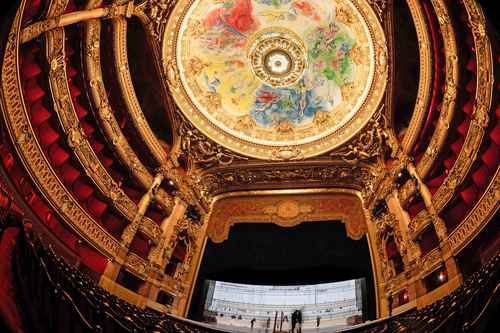Paris. The lavish building of the Opera Garnier in Paris, which has hosted the most renowned voices and dance companies in the world on its stage, turns 150 years old on January 5.
On the same date, but in 1875, after 14 years of works directed by the architect Charles Garnier, the Opera was inaugurated with great pomp by Mac Mahon, president of France.
At the opening of the building, commissioned by Napoleon III that cost 36 million gold francs (about 7 billion pesos), 2,000 guests from all over Europe attended, including some members of royalty.
At the time of its inauguration it was the largest opera house in the world: 173 meters long and 125 meters wide.
explained the guide Jean Jacques Serres, who also highlighted that his setting was the biggest
27 meters deep, 48 meters wide (including the backstage) and 60 meters high. Three times the size of a Broadway stage!
he pointed out.
Its façade, currently covered by a canvas due to a renovation, impresses with its opulence, rich in polychrome materials, golden masks, medallions and allegories, and contrasts with the architecture of Baron Haussmann.
The two men did not get along. Haussmann had built buildings around it that were slightly taller than planned. Garnier, angry, added a few meters to his façade
Serres said.
The interior is also majestic, with its monumental staircase and marble types.
Historical monument
If the building, classified as historical monument
in 1923, is so visited every year – one million people in 2023 – is also due to the brightly colored frescoes and floating characters sewn to the ceiling of the performance hall, signed by Marc Chagall.
The fresco, a tribute to 14 composers of operas and ballets, was commissioned by Minister of Culture André Malraux in 1964, who did not like the original, damaged ceiling by Jules Eugène Lenepveu.
Among the boxes, number 5 is special. It is that of Éric, the ghost of Gaston Leroux’s novel
Serres explains.
The author of The Phantom of the Opera (1910) imagined this character who came to listen to a soprano with whom he fell in love, always wearing a mask, so that the scars left on his face by an accident would not be seen.
Dancers of the stature of the Russian Tamara Toumanova or the Frenchman Patrick Dupond, and singers such as Maria Callas and Fiódor Shaliapin, have performed on its famous stage.
It will be empty for two years
It is precisely in the cage
of the stage, the space that surrounds it above and below, where, starting in the summer of 2027, equipment modernization and renovation works will be carried out that will prevent any show for two years.
On the fifth floor of the basement there is a huge tank used by Garnier as a counterweight to stabilize the building’s foundation.
Water was very valuable because fire represented the main enemy of performance halls
Serres recalls. Today, the tank is used for firefighters to train in a closed environment
details.
You can also visit the old engine room, with its winches and cables. Once manipulated by workers aided by counterweights, they were used to raise or lower curtains and fabrics painted in trompe l’oeil. Over time, they were replaced by electric motors.
From there you can see the first basement and its trapdoor, which allowed Giselle, the heroine of the ballet, to disappear, while the inscription appears on a wall shelter A
.
The Opera served as a refuge to the people of the neighborhood during World War II
and a line marks the level that the water reached during the flood of January 31, 1910.
Another notable element is the staircase called of the elephant
where a pachyderm lent by a circus passed by for a performance of The gallant Indian women, by Jean-Philippe Rameau.
On the upper floors are the personal or collective dressing rooms of the 154 ballet dancers and, in the upper part, the five rehearsal studios.
